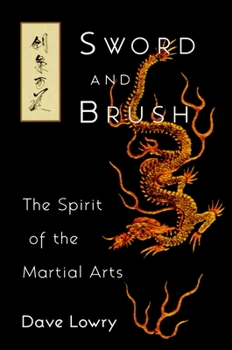Sword and Brush: The Spirit of the Martial Arts
Select Format
Select Condition 
Book Overview
This moment of perfect clarity that is the force behind all the traditional Japanese arts--from archery to flower arranging--is celebrated here in Dave Lowry's exploration of the common principles... This description may be from another edition of this product.
Format:Paperback
Language:English
ISBN:1570621128
ISBN13:9781570621123
Release Date:September 1995
Publisher:Shambhala
Length:136 Pages
Weight:0.50 lbs.
Dimensions:0.4" x 5.8" x 9.0"
Customer Reviews
5 ratings
Worth multiple readings
Published by Thriftbooks.com User , 19 years ago
Dave Lowry has written an excellent book that I've read on more than one occassion. As a bugeisha (one that studies the traditional Japanese martial ways) this small treatise on terms, kanji and philosophy used in most budo settings is quite enthralling. I've found that as I've progressed in my own training, Mr. Lowry's "Sword and Brush" becomes even more profound. Going to my bookshelf, dusting off the book cover and reading it each year has proven fruitful. His simple and direct approach provide insight into shodo (the way of the brush), a particular kanji(s) history, which allows the reader to visualize the origins of the pictograph, and its transcendence into the combat ways of Japan. Each philosophical overview imparts a wisdom found by one who has truly studied the arts and can teach intricate meanings to the reader. Lowry is a true student of the arts; an individual steeped in budo and bujutsu. He gets "it," and tries to share his knowledge with others. Buy this book, you won't regret it.
The way of calligraphy illuminates the way of the warrior
Published by Thriftbooks.com User , 19 years ago
This elegant book from renowned martial arts author Dave Lowry is both enlightening and pleasing to the spirit. Mixing examples of his masterful brush work with insightful and thought provoking stories, Lowry delves into the deeper meaning of common martial concepts. It is easy reading yet profound. I read it for the first time nearly a decade ago then recently picked it up again. I do not know if it is the natural maturity that comes with age or through the furtherance of my martial training but I have found it even better the second time around. If you are looking for deeper meaning in from your budo training, this work belongs on your bookshelf! Lawrence Kane Author of Surviving Armed Assaults, The Way of Kata, and Martial Arts Instruction
Inspiring
Published by Thriftbooks.com User , 22 years ago
Swordsman and calligrapher Dave Lowry discusses 42 Japanese concepts. Amongst other things, he covers do (the Way), martial arts teachers, training in the martial arts, timing, ku (emptiness), tan (forging), intent, gei (the cultivation of craft), and austerity. I myself practice eskrima, which has nothing whatsoever to do with Japanese martial arts, yet I found this book directly inspiring and helpful to my own training, so I would recommend it to any martial artist regardless of art.
Kanji and budo
Published by Thriftbooks.com User , 22 years ago
Dave Lowery uses shodo in basic Kanji vocabulary to gives us insight into budo and zen. Shodo is the Way of calligraphy. The art of writting with brush and ink is a common metaphor for Zen thought.And this art was studied by the samuari, Shodo has many similarities with the way of the sword as can be seen in the essays that Lowery has for each kanji character. This book is a great evening read.
Insight into the meaning of martial arts-related caligraphy
Published by Thriftbooks.com User , 27 years ago
Lowry, an accomplished martial artist, teacher and student of Asian history, presents another terrific insight into the wonderful world of the martial arts. Each "chapter" begins with the traditional japanese caligraphy for a common martial arts term. Lowry then breaks the components of the caligraphy character(s)which gives even seasoned students of the martial arts a new perspective on both the term and their training. This is followed with commentary and insights into how this relates to the martial arts training experience. The calligraphy for "Kyu" (color-belt ranks) for example is dissected into elements that represent the "tying together of threads." Lowry then allows the reader to "discover" how this relates to martial arts training (my "discovery" was that, just as threads are woven together to make cloth, the experiences of a "lower rank" student are "woven" together to create a "black belt" rank.) I highly recommend this book to intermediate and advanced students of Japanese martial arts. Lowry's perspective allows the reader to fully understand what previously were "simple concepts" and re-evaluate the way they approach their training.




